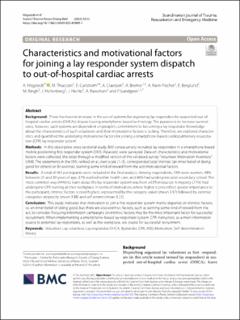| dc.contributor.author | Högstedt, A. | |
| dc.contributor.author | Thuccani, M. | |
| dc.contributor.author | Carlström, Eric | |
| dc.contributor.author | Claesson, A. | |
| dc.contributor.author | Bremer, A. | |
| dc.contributor.author | Ravn-Fischer, A. | |
| dc.contributor.author | Berglund, E. | |
| dc.contributor.author | Ringh, M. | |
| dc.contributor.author | Hollenberg, J. | |
| dc.contributor.author | Herlitz, J. | |
| dc.contributor.author | Rawshani, A. | |
| dc.contributor.author | Lundgren, P. | |
| dc.date.accessioned | 2022-06-07T10:19:04Z | |
| dc.date.available | 2022-06-07T10:19:04Z | |
| dc.date.created | 2022-04-09T15:21:59Z | |
| dc.date.issued | 2022 | |
| dc.identifier.citation | Högstedt, A., Thuccani, M., Carlström, E., Claesson, A., Bremer, A., Ravn-Fischer, A., Berglund, E., Ringh, M., Hollenberg, J., Herlitz, J., Rawshani, A. & Lundgren, P. (2022). Characteristics and motivational factors for joining a lay responder system dispatch to out-of-hospital cardiac arrests. Scandinavian Journal of Trauma, Resuscitation and Emergency Medicine, 30, Artikkel 22. | en_US |
| dc.identifier.issn | 1757-7241 | |
| dc.identifier.uri | https://hdl.handle.net/11250/2997657 | |
| dc.description.abstract | Background: There has been in increase in the use of systems for organizing lay responders for suspected out-of-hospital cardiac arrests (OHCAs) dispatch using smartphone-based technology. The purpose is to increase survival rates; however, such systems are dependent on people’s commitment to becoming a lay responder. Knowledge about the characteristics of such volunteers and their motivational factors is lacking. Therefore, we explored characteristics and quantified the underlying motivational factors for joining a smartphone-based cardiopulmonary resuscitation (CPR) lay responder system.
Methods: In this descriptive cross-sectional study, 800 consecutively recruited lay responders in a smartphone-based mobile positioning first-responder system (SMS-lifesavers) were surveyed. Data on characteristics and motivational factors were collected, the latter through a modified version of the validated survey “Volunteer Motivation Inventory” (VMI). The statements in the VMI, ranked on a Likert scale (1–5), corresponded to(a) intrinsic (an inner belief of doing good for others) or (b) extrinsic (earning some kind of reward from the act) motivational factors.
Results: A total of 461 participants were included in the final analysis. Among respondents, 59% were women, 48% between 25 and 39 years of age, 37% worked within health care, and 66% had undergone post-secondary school. The most common way (44%) to learn about the lay responder system was from a CPR instructor. A majority (77%) had undergone CPR training at their workplace. In terms of motivation, where higher scores reflect greater importance to the participant, intrinsic factors scored highest, represented by the category values (mean 3.97) followed by extrinsic categories reciprocity (mean 3.88) and self-esteem (mean 3.22).
Conclusion: This study indicates that motivation to join a first responder system mainly depends on intrinsic factors, i.e. an inner belief of doing good, but there are also extrinsic factors, such as earning some kind of reward from the act, to consider. Focusing information campaigns on intrinsic factors may be the most important factor for successful recruitment. When implementing a smartphone-based lay responder system, CPR instructors, as a main information source to potential lay responders, as well as the workplace, are crucial for successful recruitment. | en_US |
| dc.language.iso | eng | en_US |
| dc.rights | Navngivelse 4.0 Internasjonal | * |
| dc.rights.uri | http://creativecommons.org/licenses/by/4.0/deed.no | * |
| dc.title | Characteristics and motivational factors for joining a lay responder system dispatch to out-of-hospital cardiac arrests | en_US |
| dc.title.alternative | Characteristics and motivational factors for joining a lay responder system dispatch to out-of-hospital cardiac arrests | en_US |
| dc.type | Peer reviewed | en_US |
| dc.type | Journal article | en_US |
| dc.description.version | publishedVersion | en_US |
| dc.rights.holder | © The Author(s) 2022. | en_US |
| dc.source.pagenumber | 22 | en_US |
| dc.source.volume | 30 | en_US |
| dc.source.journal | Scandinavian Journal of Trauma, Resuscitation and Emergency Medicine | en_US |
| dc.identifier.doi | https://doi.org/10.1186/s13049-022-01009-1 | |
| dc.identifier.cristin | 2016375 | |
| cristin.ispublished | true | |
| cristin.fulltext | original | |
| cristin.qualitycode | 1 | |

